WORLD CLASS COACHING
4-2-3-1 Defending
By Luca Bertolini
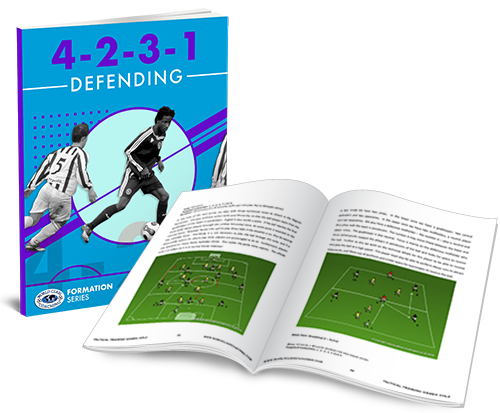
Table of Contents
PART ONE
Introduction
Basic Principles of Play and Responsibilities Without the Ball - Part 1
PART TWO
Basic Principles of Play and Responsibilities Without the Ball - Part 2
PART THREE
Juventus 2016-2017 case analysis: the art of the 1-4-2-3-1 defense phase - Part 1
PART FOUR
Juventus 2016-2017 case analysis: the art of the 1-4-2-3-1 defense phase - Part 2
Introduction
The main benefit of the 4-2-3-1 formation is that the players are spread across the pitch proportionately and never too far away among themselves and from an opponent; this way they can close the spaces and limit the playing time to the possession team easily.
1-4-2-3-1 is the only basic formation among the most used on the field, but 1-3-3-1-3 (or 3-1), which in fact it’s a potential attacking development, that shapes 4 lines of players “on paper”; if the opponents start the possession phase from the goalkeeper, they should overcome ideally four lines of pressing opponents before finishing or two compact lines of 4, thinking about the easiest wingers movements, retreating back along the flank, to shape the midfield line.
The center of the field is usually strong enough with the two center backs and central midfielders in front of the goal and the team can be confident to control the game, forcing the opposition possession toward the center, where numerical advantage is always ensured and leaving space down the sidelines
On the other side, the team can be weak down the flanks if the wingers don’t track back, when the opposition is able to combine out wide; this is the reason why the first defensive idea about 1-4-2-3-1 is to call the wingers back along the center midfielders line and ask them not to leave the fullbacks alone in 1 v 1 duels. This situation becomes very dangerous if a counterattacking pass is received by one of the opposing wingers behind the pressure lines.
The wingers are the supposed to track back automatically, both if there are pressure chances for immediate possession recovery or not.

In this ideal situation, all the players are supposed to be positioned properly as their roles ask them, just after the loss of possession and wherever the ball has been wrongly passed, received or intercepted by the opposition.
The center forward and the advanced center midfielders seem to be only players who can press the opposition possession phase; balance and coverage are dominant in this idea.
This basic defending tactical idea is not really wrong, as it’s useful to fix the main issue of this system of play, but it doesn’t take into account the opposition’s attacking actions; it is related to defensive positioning rather than to defending actions which may allow possession recoveries.
High and aggressive pressing oriented teams like Manchester City are usually shaped in this formation when the pressure phase inside the attacking and middle thirds failed and they are forced inside the final third against opponents with two forwards along the defense line.
Manchester City opponents are shaped in a basic 1-3-4-2-1 formation, and usually one of the three attacking players moves wide and the second one move up beside the center forward, as in this picture.
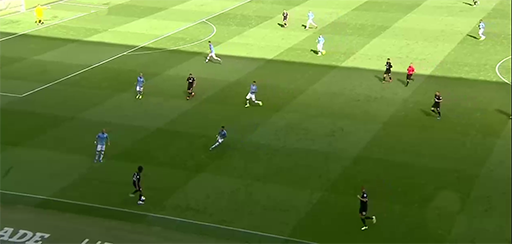
The center backs, Otamendi and Laporte can control the first center forward, the opposite fullback on the left side, Zichenko, can control the second center forward. Man City midfielders, Rodri and De Bruyne, are much closed to the defense line.
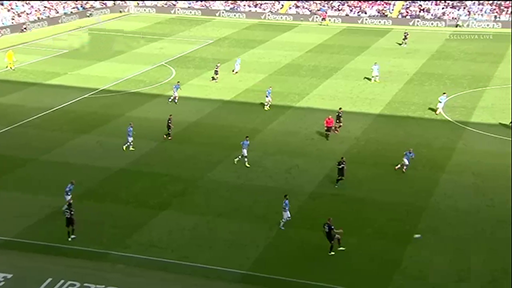
The fullback near the ball, Walker, is not involved in a 1 v 1 duel thanks to the right winger, Mahrez, who retreats his position, force a back pass and press the receiver, directing the opposition possession phase backward.
The opposite left winger, Sterling, has made the same back run and despite being oriented toward the ball position, he could be able to cover the space along the flank, in case of a switch of side.
This second image is also interesting as the center advanced midfielder, David Silva, has retreated back in front of the holding midfielders, as second forward.
Wherever the second forward is placed, beside the center striker or beside him, the main movements are made by the wingers, who help the fullbacks not be involved in 1 v 1 duel near the ball and to be easily under pressure along the opposite flank.
The Premier League match against Brighton & Hove Albion (08/31/2019) was very interesting, because it showed how 1-4-2-3-1 can be liquid, with constant exchanges of positioning as holding midfielder and advance midfielder between De Bruyne and David Silva.
Another possible defense shape development of 1-4-2-3-1 is the 1-4-3-3; the advanced center midfielder drops back in between the holding midfielders.
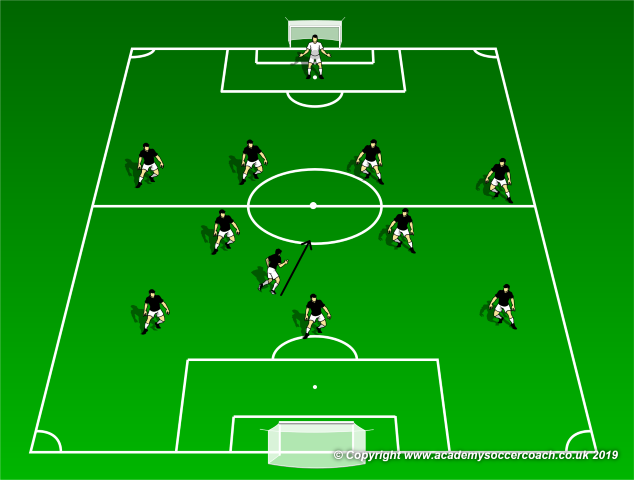
The most important thing is to understand the reason why behind this movement; the opponents ensured a momentary numerical advantage near the ball (3 v 1) and Man City creates numerical advantages situations against the potential receivers, being positioned very narrow. (One of the center holding midfielders is pressing the up the pitch trying to force the opposition pressure backward).
1. 6 v 3 inside the defending half
2. 2 v 1 on the left (left fullback Zichenko and second holding midfielder Rodri)
3. 2 v 1 duels in the center (center backs and fullbacks: Otamendi + Walker and Laporte + Zichenko)
4. The right winger Mahrez is trying to screen a wide pass toward the flank
5. The center advanced midfielder, De Bruyne drops back to take the role of center holding midfielder to protect the back four.
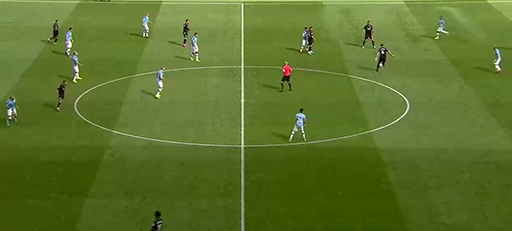
This defending action is not only an established tactical development of the system of play, but it’s a precise answer to the non-possession tactical situation of play. This situation can be considered a 1-4-2-2 also, but the right winger, Mahrez, is ready to take the role of third midfielder on the right side of the momentary holding midfielder.
We may also think about the possible shape inside the first third, with the advance center midfielder who drops back between the center midfielders or who covers a space in the middle if one teammate has shifted wide, shaping a strong defensive 1-4-5-1.
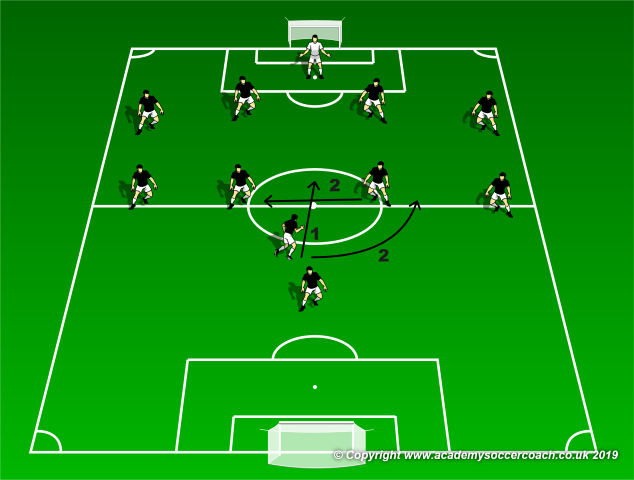
Again, there is a precise tactical reason behind this Man City defense shape; the opponents, Liverpool, asks both fullbacks too push up during possession phases and three forwards are always positioned along the opposition defense. The back four must control the opposition attacker and none of them can move forward. The 4 v 3 numerical advantage is not huge also.
The main principle of play for Pep Guardiola is to defend running forward and, as in this situation is not possible, Man City tries not to lose yards on the field, screening any forward potential pass by the ball carrier. The only possible pass for Liverpool is received among 3 center midfielders (De Bruyne, Rodri and David Silva) and the center forward (Aguero).
Liverpool places a line of 5 players in the middle third; Man City wingers (Bernardo Silva and Sterling) control the opposition fullbacks and the only way to be sure of numerical advantage in the center is to ask the advanced midfielder (David Silva) to drop back and cover the space on the right of the midfield trio, as one of the holding midfielders (Rodri) has dropped a bit deeper to screen center passing paths. This way a 6 v 5 duel is created in the middle third, thanks to the center forward, who drops back to overload the center and the ball area.
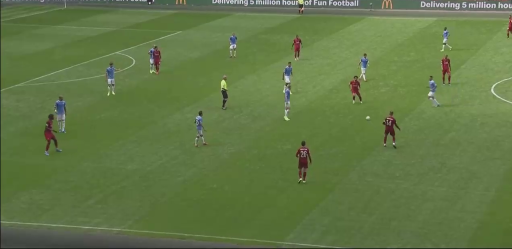
Here again, the 1-4-5-1 is not an automatic tactical solution, but an answer to the tactical situation.
The real question about the reason why 1-4-2-3-1 should be chosen as system of play, from a defensive point of view, finds its answers in the philosophic principles of play that Juan Manuel Lillo told us in the middle of the ‘90s, talking about this formation shape: “To ensure high pressure, thanks to 4 advanced players and to regain the ball as soon as possible in case of loss of possession, providing center defensive cover thanks to the 2 holding midfielders”…(both if they are considered double pivots, holding midfielder and advanced play maker or two box to box players; it’s only a matter of where and how they cover the center and when and how they press in the middle third)… “And being safe at the back because of 5 players, even if one of the fullbacks has pushed forward.”
[…] "It was the most symmetrical way I could find of playing with four forwards. One of the great advantages is that having the forwards high allows you to play the midfield high and the defense high, so everybody benefits”. These last words give us the idea of the main defense principle behind the 1-4-2-3-1: stay positioned high on the field or as high as possible thanks to aggressive pressure as implementation of the transition to defend phase.This idea requires fast and disciplined attackers (the front four first of all) to press the opposition defense line while building up from the back, to track back to support the defense phase (or pressure actions) of the midfielders if the first pressure phase is overcome; the center players (center backs and center midfielders) must provide coverage and balance.
We may now think that it’s possible to divide the team into two parts; 4 (3+1) attacking player and 7 defending players (1-4-2); but this would be true only “on paper”, just like the wingers retreating back and the advanced midfielder dropping back into the midfield line.
These are shapes that can be obviously found on the field, as we just analyzed in the first pages, but they are consequences of the situations of play, not tactical ideas; as Juan Manuel Lillo was used to say, the idea behind the 1-4-2-3-1 system of play is to create a pressing team, when it is involved in defending phases and a liquid team organization to recover the ball immediately after its loss, wherever it’s lost and whoever has lost the possession.
With fast forwards up front, the team may decide to press deep in the opposition’s half in an attempt to win the ball back further up the pitch. By shifting across the field quickly they can force the opponents into a precise area, as in the following example, or technical mistakes.
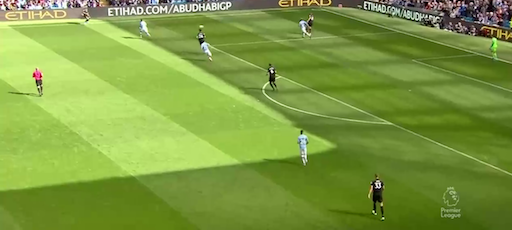
The initial 4 v 5+gk duel is reduced to a 3 v 3 duel around the ball, making the building up phase very hard to carry out.
The opposition possession phase is forced deep toward the right side of the own box and a 3 v 3 duel is created to put all the nearest passing options under aggressive pressure.
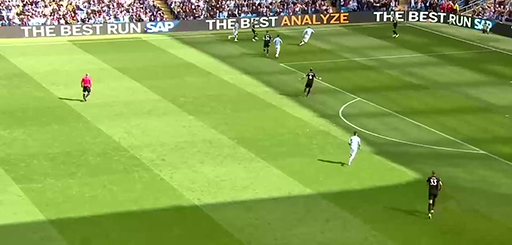
Alternatively, the three advanced midfielders may drop back and form line of five (3+2) across the upper part of the middle third, that reverts to a 4-5-1 inside the lower area of the middle third, which is both solid in the center and out wide, as we shown in the prior example of Manchester City – Liverpool Community Shield match.
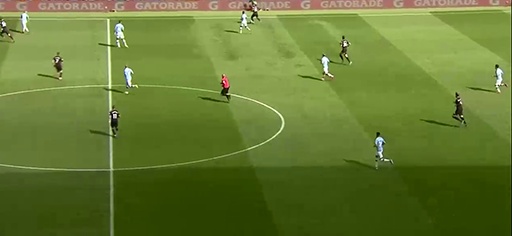
In this situation, the opposition has been able to play out despite the pressure inside the first third; but the reaction has been immediate, as the 3 advanced midfielders have tracked the opponents to be positioned between the first line of possession players and any further potential forward passing path.
The right winger Sterling is playing 1 v 1 against the ball carrier, the advanced center midfielder (David Silva here) can press the nearest inside passing option, which is anyway very difficult to play, as the ball carrier is turned toward the side line, and the right winger Mahrez can counter the third opponent of the line quickly. Never the less the center forward could double team these potential receivers, retreating back or counter attack quickly in case of ball recovery.
Behind this first pressure line, the center holding midfielders are screening forward ground passes, shifting across the left defending flank (Rodri and De Bruyne may intercept any diagonal pass attempt toward the opposition center midfielders, and the left fullback Zichenko is closing the space along the side line.
Here we can find two kinds of 3 v 3 duels:
1. The advanced midfielders are pressing the opposition ball carrier and the passing options that could open the spaces along the opposite side
2. The holding midfielders and the left fullback are closing the nearest potential forward passing options, to prevent the opponents from playing thought the middle third.
A long areal pass is forced along the right flank as result of the pressure of the three advanced midfielders and of the holding center midfielders’ space closure behind them.
Depth defense is very easy, as none of the opposition attackers could be placed high, trying to help the teammate in possession.
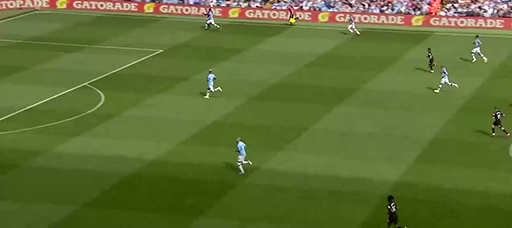
The left center back Laporte can close the receiver very wide on the right flank and win the ball back.
This is basically what Juan Manuel Lillo was looking for, by my side; try the hardest to recover the possession high on the field, and he thought that 1-4-2-3-1 was the best system of play to do it, but if it’s not possible, try to recover the ball in a manner that the biggest number of players of the team can stay placed high to attack again very quickly.
Basic principles of play and players tasks without the ball
Pressure – When possession is lost, the nearest player(s) try to regain the ball or to delay the opposition attack, applying pressure on the ball; the farther player(s) help this action by making recovery runs to deny the opponents the chance to play forward quickly.
Pressure phase can be divided into 3 different actions:
• Counter-pressing: it is the pressure around the ball during the transitions to defend phase of play, just after the loss of possession, to try to force the opposition toward a specific area, to win the ball back as soon as possible. Counter-pressing is totally on the opposite side of system of play, because it depends only from the situation of play (when the possession is lost) and from the area where the ball is lost. It’s not strictly related to players’ roles, but only to their positions on the field at the moment of loss of possession.
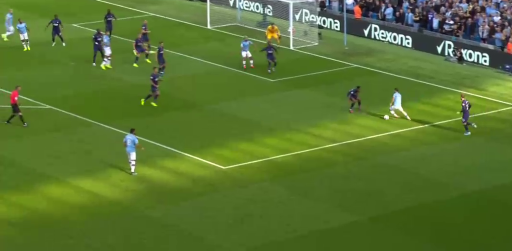
As instance, Bernardo Silva tries to dribble inside the box from the left side of the opposition box, as inverted winger, to win a 1 v 1 duel before finishing.
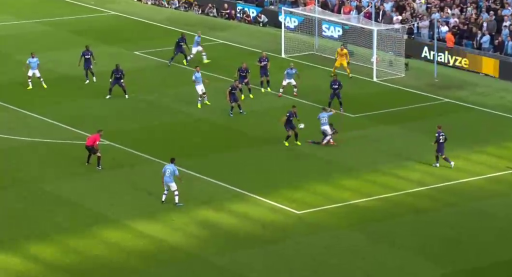
But he is double teamed inside the box and covered on his left foot; this way, he can’t shot and loses the possession.
The right winger Sterling is positioned inside the box, as well as Aguero (CF), Rodri, one of the holding midfielders and Zichenko, the left fullback. Gundogan, the second holding midfielder is just out of the penalty area.
If we would think about the defensive phase as just a players’ role relation and change of positions on the field, we should say that Manchester City is catch totally unbalanced in the middle third and the back and that the team is out of shape.
But if we think about the line of five attacking player that City usually shapes inside the opposition first third, we realize that the situation is not like it seems.
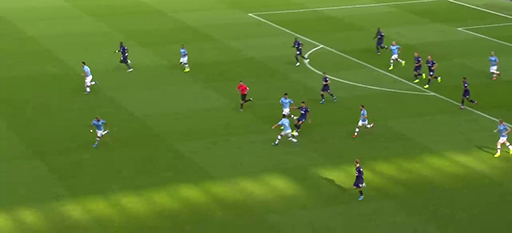
As the opponent in possession tries to dribble the ball up the field, Gundogan, the balance player behind the ball area presses him immediately, while Bernardo Silva, who lost the possession, is retreating back and Rodri, who recovers the position, put him under immediate pressure as well, creating a 3 v 1 duel near the ball. De Bruyne is running back from the right attacking deep flank.
The left winger Sterling is running back to cover Zichenko position as an opponent is acting as potential option along the defending left flank, Laporte is also running back to cover the depth and double team him if he receive and Walker is running back along the center-right middle third to cover the potential space that could be available if the opponent on the right defending flanks would receive.
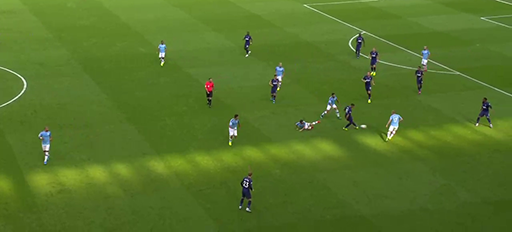
The ball carrier is forced to play backward and Tottenham hasn’t been able to move up the pitch because of this aggressive pressure and the consequent risk of loss of possession inside the first third, and the defensive 1-4-1-4 has been maintained at the back.
Manchester City can stay positioned high on the field; the opposition must be positioned backward and its defending shape has been broken also, as the left winger has pushed a little higher, delaying the back run to cover the gap that has been created inside the left defending side.
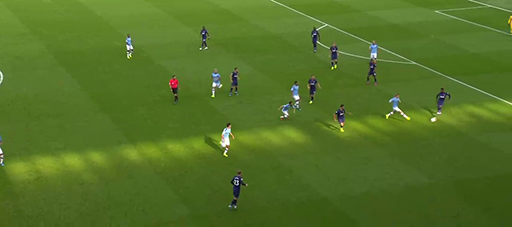
The receiver of the back pass, the opposition left fullback, is immediately under pressure again, thanks to De Bruyne’s diagonal run from the right deep attacking flank and he can only play forward with a one touch pass trying to exploit the space on the left side.
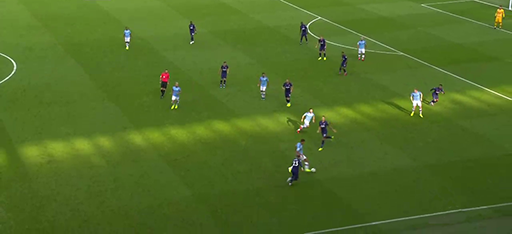
The left winger is too far away and too much on late to receive and Rodri can intercept the ball, shifting wide from the center; Man City can now exploit the gap to counter attack.
The opposition defense is strongly shape in the middle of the first third, but weak along the left side, as De Bruyne may attack the direct opponent in a 1 v 1 duel, if he receives.
De Bruyne receives and he can turn toward the goal, as Bernardo Silva overlaps, inviting the opposition left fullback to track him.
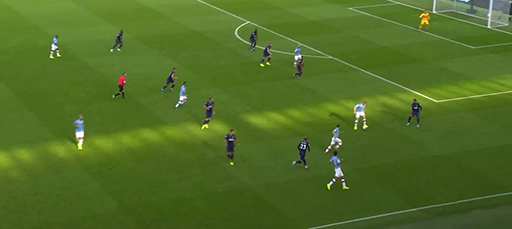
The opposition defense is again forced inside the 18 y box, and the ball carrier can dribble the ball, facing the goal.
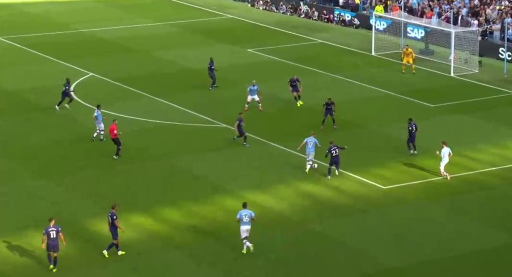
• Aggressive pressure: it is the pressure phase of the defending team, when the opposition has already made the possession safe, to force the direction of play backward or sideward, denying time and space and, if possible, to win the ball back directly or after a wrong choice of an opponent.
These are two different situations of play, but where the defending team pressure has the same goal.
1. Manchester City is shaped in a classic 3-1 advanced formation and the players are involved in a numerical disadvantage situation (5+gk v 4). Aguero, as center forward, is pressing the opposition ball carrier backward toward the goalkeeper; the back three are not countering the opponents directly to avoid gaps and passing lanes opening. Easy but not dangerous sideways passing options are given to the opposition ball carrier; otherwise, they are screening all the forward passing lanes.
Aguero is forcing the ball carrier backward, the left winger Sterling can attack the right center back if he receives, as well as, the right winger Mahrez can counter the left center back on the other side. The center advanced midfielder is acting a balance player behind them and he may counter the opposition holding midfielder in the center and the advanced one at his left.
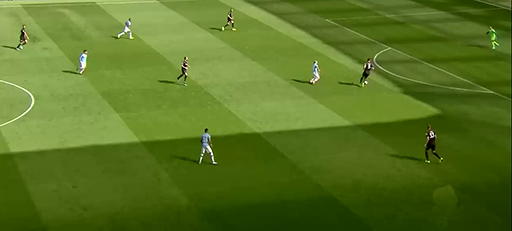
2. In this second example the defense pressure formation of Citizens has been broken, as the opposition has been able to overcome the first line that was shaped by Aguero and Zichenko, who pushed up during the possession phase.
The main objective for the defending team is to prevent the opponents from playing forward; for this reason the ball area around the ball carrier is overload, giving him the chance for a wide pass toward the left. Mahrez shifts across from the right to press the ball carrier, Sterling, David Silva and Rodri are forcing him toward the pressing teammate, screening any passing option toward the defending left side.
The direction of the opposition possession is then forced toward a specific area of the field through a combination of individual pressure and closure of passing lanes.
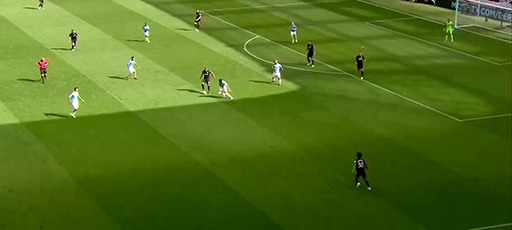
• Positional pressure: basically it is the closure of passing lanes to the opposition to force mistakes or direct the attacking phase toward a specific area of the field, where a defense numerical advantage can be exploited to put aggressive pressure. In this case, as the definition suggests, the positions of the players on the field is very important to ensure coverage and balance to not create gaps into the defense shape. This is the perfect situation to put into practice Juanma Lillo second dogma, “Positional Play” from a defensive point of view; and, by my side, it’s the reason why the 1-4-3-2-1 can really exploit the defense phase of the front four and the balance actions of the holding center midfielders.
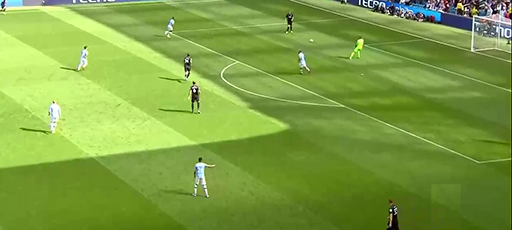
The opposition goalkeeper passes the ball to the right center back inside the box, the receiver is immediately screened by the left winger Sterling and Aguero is moving to cover the nearest passing lanes toward the center and the defending left side; a first 2 v 2 is created around the ball. Mahrez on the right, De Bruyne in the center and David Silva on the left, behind the pressing teammate are closing any further passing lanes and the nearest receivers could be under fast pressure. A 3 v 3 general duel is created at the back of the pressure zone, as well as a potential 3 v 2 against the nearest opposition passing options.
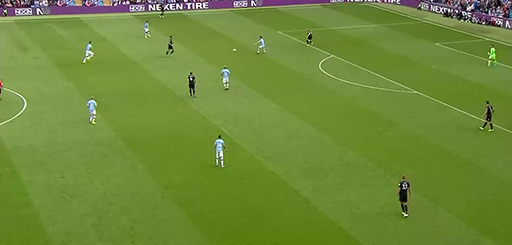
As one opponent drops back to receive between the pressure lane, the ball area is condensed, exploiting the numerical advantage in the area; a front and back 2 v 1 duel is created against the opposition receiver (David Silva and Rodri), Sterling could press the wide passing option on the left, Mahrez on the right, De Bruyne in the center and Aguero, who is placed beside the first possible receiver of a following pass, are forcing the opposition possession toward the receiver, who is going to be under pressure.
A general 6 v 7 situation can be recognized inside the opposition half, but a 6 v 2 duel is created around the ball.


